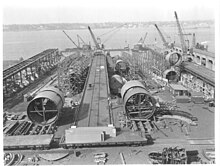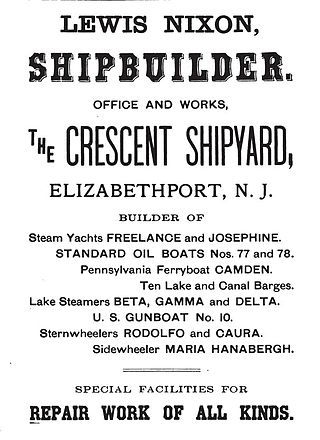

The Victory Yard was a temporary expansion of the General Dynamics Electric Boat facility in Groton, Connecticut, to dramatically increase submarine construction during World War II.


The Victory Yard was a temporary expansion of the General Dynamics Electric Boat facility in Groton, Connecticut, to dramatically increase submarine construction during World War II.
On 5 February 1942, the US Navy purchased the former Groton Iron Works property from Alfred Holter and Shell Oil Company for $222,000 using condemnation proceedings. [1] $9.5 million was spent to construct the Victory Yard, where General Dynamics Electric Boat began building submarines on 22 July 1942. [2] On 3 November 1943 a Federal Court Committee awarded an additional $203,000 to the former owners. [3]
| EB Hull # [4] | Way [4] | Name [4] | Class [4] | Keel Laid | Launched | Commissioned |
|---|---|---|---|---|---|---|
| 66 | 2-V | USS Dace (SS-247) | Gato | 22 July 1942 [5] | 25 April 1943 [5] | 23 July 1943 [5] |
| 68 | 3-V | USS Dorado (SS-248) | 27 August 1942 [6] | 23 May 1943 [6] | 28 August 1943 [6] | |
| 71 | 4-V | USS Flasher (SS-249) | 30 September 1942 [7] | 20 June 1943 [7] | 25 September 1943 [7] | |
| 73 | 5-V | USS Flier (SS-250) | 30 October 1942 [8] | 11 July 1943 [8] | 18 October 1943 [8] | |
| 76 | 6-V | USS Flounder (SS-251) | 5 December 1942 [9] | 22 August 1943 [9] | 29 November 1943 [9] | |
| 78 | 7-V | USS Gabilan (SS-252) | 5 January 1943 [10] | 19 September 1943 [10] | 28 December 1943 [10] | |
| 79 | 8-V | USS Bream (SS-243) | 5 February 1943 [11] | 17 October 1943 [11] | 24 January 1944 [11] | |
| 80 | 9-V | USS Cavalla (SS-244) | 4 March 1943 [12] | 14 November 1943 [12] | 29 February 1944 [12] | |
| 81 | 10-V | USS Cobia (SS-245) | 17 March 1943 [13] | 28 November 1943 [13] | 29 March 1944 [13] | |
| 82 | 1-V | USS Croaker (SS-246) | 1 April 1943 [14] | 19 December 1943 [14] | 21 April 1944 [14] | |
| 89 | 2-V | USS Becuna (SS-319) | Balao | 29 April 1943 [15] | 30 January 1944 [15] | 27 May 1944 [15] |
| 91 | 3-V | USS Besugo (SS-321) | 27 May 1943 [16] | 27 February 1944 [16] | 19 June 1944 [16] | |
| 93 | 4-V | USS Caiman (SS-323) | 24 June 1943 [17] | 30 March 1944 [17] | 17 July 1944 [17] | |
| 95 | 5-V | USS Blower (SS-325) | 15 July 1943 [18] | 23 April 1944 [18] | 10 August 1944 [18] | |
| 98 | 6-V | USS Charr (SS-328) | 26 August 1943 [19] | 28 May 1944 [19] | 23 September 1944 [19] | |
| 100 | 7-V | USS Brill (SS-330) | 23 September 1943 [20] | 25 June 1944 [20] | 26 October 1944 [20] | |
| 102 | 8-V | USS Bullhead (SS-332) | 21 October 1943 [21] | 16 July 1944 [21] | 4 December 1944 [21] | |
| 104 | 9-V | USS Cabezon (SS-334) | 18 November 1943 [22] | 27 August 1944 [22] | 30 December 1944 [22] | |
| 106 | 10-V | USS Capitaine (SS-336) | 2 December 1943 [23] | 1 October 1944 [23] | 26 January 1945 [23] | |
| 108 | 1-V | USS Carp (SS-338) | 23 December 1943 [24] | 12 November 1944 [24] | 28 February 1945 [24] | |
| 110 | 2-V | USS Entemedor (SS-340) | 3 February 1944 [25] | 17 December 1944 [25] | 6 April 1945 [25] | |
| 112 | 3-V | USS Chopper (SS-342) | 2 March 1944 [26] | 4 February 1945 [26] | 25 May 1945 [26] | |
| 114 | 4-V | USS Cobbler (SS-344) | 3 April 1944 [27] | 1 April 1945 [27] | 8 August 1945 [27] | |
| 116 | 5-V | USS Corporal (SS-346) | 27 April 1944 [28] | 10 June 1945 [28] | 9 November 1945 [28] |
On 13 January 1945, General Dynamics Electric Boat announced that $3,000,000 will be spent to convert the Victory Yard to manufacture 105mm shells. [29]
On 18 December 1946, Pfizer Inc purchased the property from the War Assets Administration. [30] Purchase price was $911,999. [31]
General Dynamics Electric Boat (GDEB) is a subsidiary of General Dynamics Corporation. It has been the primary builder of submarines for the United States Navy for more than 100 years. The company's main facilities are a shipyard in Groton, Connecticut, a hull-fabrication and outfitting facility in Quonset Point, Rhode Island, and a design and engineering facility in New London, Connecticut.

Naval Submarine Base New London is the primary United States Navy East Coast submarine base, also known as the "Home of the Submarine Force." It is located in Groton, Connecticut directly across the Thames River from its namesake city of New London.

USS Dorado (SS-248), a Gato-class submarine, was the first submarine of the United States Navy to be named for the dorado.

USS Mackerel (SS-204), the lead ship of her class of submarines, was the first ship of the United States Navy named for the mackerel. Mackerel and her near-sister Marlin were prototype small submarines which the Navy was exploring to replace the aging S-class submarines.

USS Marlin (SST-2), originally USS T-2 (SST-2), was a T-1-class training submarine in commission from 1953 to 1973. She was the second submarine of the United States Navy to be named for the marlin, a large game fish. Except for the first 25 early development pre-World War I submarines, she was one of the smallest operational submarines ever built for the U.S. Navy.

USS Perch (SS-176) - a Porpoise-class submarine, was the first ship of the United States Navy to be named for the perch.

Crescent Shipyard, located on Newark Bay in Elizabeth, New Jersey, built a number of ships for the United States Navy and allied nations as well during their production run, which lasted about ten years while under the Crescent name and banner. Production of these ships began before the Spanish–American War and occurred far before the outbreak of World War I. Arthur Leopold Busch, a recent emigre from Great Britain, started the yard with former Navy Lt. Lewis Nixon in January 1895. Both men previously worked for William Cramp & Sons in Philadelphia. Both Nixon and Busch were regarded to be amongst the best in their respected fields - and what they did at this time - as designers and builders of the latest, most advanced types of ships.

Groton is a town in New London County, Connecticut located on the Thames River. It is the home of General Dynamics Electric Boat, which is the major contractor for submarine work for the United States Navy. The Naval Submarine Base New London is located in Groton, and the pharmaceutical company Pfizer is also a major employer. Avery Point in Groton is home to a regional campus of the University of Connecticut. The town is part of the Southeastern Connecticut Planning Region. The population was 38,411 at the 2020 census.

USS Francis Scott Key (SSBN-657), a Benjamin Franklin-class ballistic missile submarine, was the only submarine of the United States Navy to be named for Francis Scott Key (1779–1843), an American lawyer, author, and amateur poet who wrote the poem "The Defense of Fort McHenry", which became the words to the United States' national anthem, "The Star-Spangled Banner". During World War II there was a liberty ship named SS Francis Scott Key.

USS Casimir Pulaski (SSBN-633), a James Madison-class ballistic missile submarine, was the second ship of the United States Navy to be named for Casimir Pulaski (1745–1779), a Polish general who served in the American Revolutionary War.

USS Springfield (SSN-761), a Los Angeles-class submarine, is the fourth ship of the United States Navy to bear the name. The boat was named in honor of both the cities of Springfield, Illinois and Springfield, Massachusetts.

USS Bluefish (SS-222), a Gato-class submarine, was the first ship of the United States Navy to be named for the bluefish. Between 9 September 1943 and 29 July 1945 she completed nine war patrols. Her operating area extended from the Netherlands East Indies to the waters south of Honshū. According to the notoriously unreliable JANAC accounting, Bluefish sank 12 Japanese ships totaling 50,839 tons.

USS Muskallunge (SS-262), a Gato-class submarine, was a ship of the United States Navy named for the muskallunge.

USS Entemedor (SS-340), a Balao-class submarine, was a ship of the United States Navy named for the entemedor, a fish of the electric ray family found in shallow waters from Baja California to Panama.

The United States' S-class submarines, often simply called S-boats, were the first class of submarines with a significant number built to United States Navy designs. They made up the bulk of the USN submarine service in the interwar years and could be found in every theater of operations. While not considered fleet submarines, they were the first submarines in the USN designed for open ocean, blue water operations. All previous submarines had been intended for harbor or coastal defense. These boats were intended to have greater speed and range than previous classes, with improved habitability and greater armament.

Fore River Shipyard was a shipyard owned by General Dynamics Corporation located on Weymouth Fore River in Braintree and Quincy, Massachusetts. It began operations in 1883 in Braintree, and moved to its final location on Quincy Point in 1901. In 1913, it was purchased by Bethlehem Steel, and later transferred to Bethlehem Shipbuilding Corporation. It was sold to General Dynamics in 1963, and closed in 1986. During its operation, yardworkers constructed hundreds of ships, for both military and civilian clients.

Frank Taylor Cable was an early pioneer in submarine development and piloted the first United States Navy submarine, USS Holland during its pre-commissioning trials.

The United States Navy Submarine Force Library and Museum is located on the Thames River in Groton, Connecticut. It is the only submarine museum managed exclusively by the Naval History & Heritage Command division of the Navy, and this makes it a repository for many special submarine items of national significance, including USS Nautilus (SSN-571). Visitors may take a 30-minute self-guided audio tour of the Nautilus.

USS Mississippi (SSN-782) is a Virginia-class submarine of the United States Navy, named for the state of Mississippi. The contract to build her was awarded to the Electric Boat Division of General Dynamics Corporation in Groton, Connecticut on 14 August 2003. Mississippi's keel was laid down on 9 June 2010. Mississippi was christened on 3 December 2011 at General Dynamics Electric Boat in Groton, Connecticut. Allison Stiller, Deputy Assistant Secretary of the Navy, is the ship's sponsor. The submarine was commissioned at a ceremony on 2 June 2012 in Pascagoula, Mississippi. SSN-782 was delivered 12 months ahead of schedule and $60 million below planned cost.

Groton Iron Works was a company formed in 1917 to build cargo ships for the United States Shipping Board during World War I. The company owned two shipyards: one in Noank, Connecticut for wooden ships; and the other in Groton, Connecticut for steel ships. The focus of this article is the Groton, Connecticut yard.